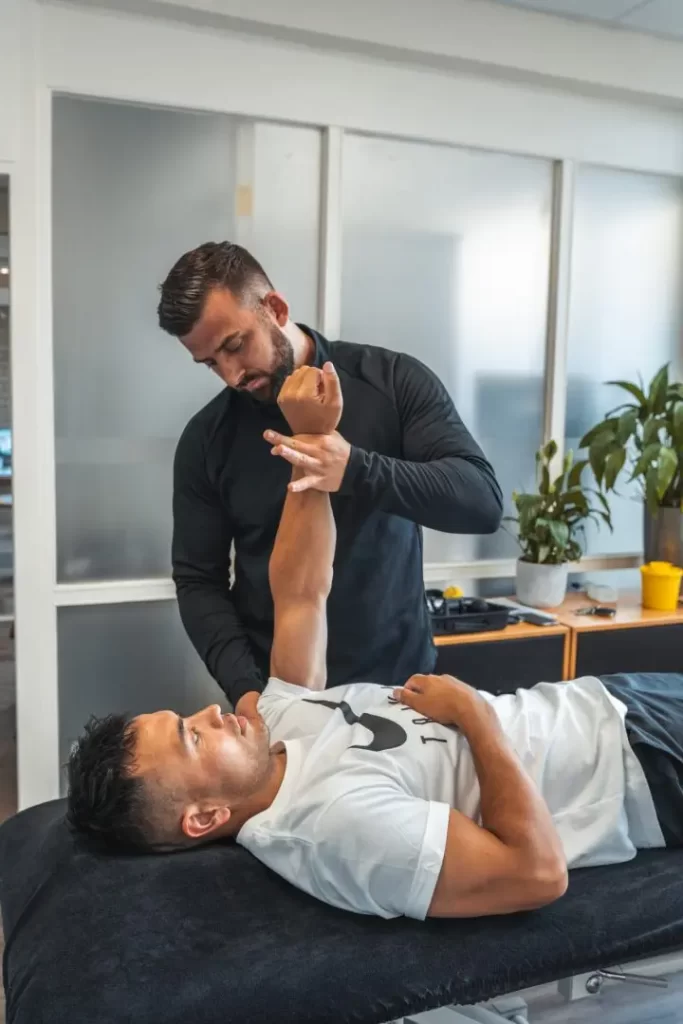Rear cruciate ligament injury
An injury to the posterior cruciate ligament (AKB) is less common than injury to the anterior cruciate ligament, but can certainly lead to functional limitations and instability of the knee. The AKB plays an important role in controlling the backward movement of the lower leg relative to the upper leg. When this ligament is damaged, it can affect daily movements, sports performance and knee stability.
At Physio Fitaal in Tilburg, we specialise in treating cruciate ligament injuries. With a combination of clinical expertise, data-driven guidance and modern facilities, we help patients rehabilitate safely and purposefully.

Cause and mechanism of occurrence of posterior cruciate ligament injury
Posterior cruciate ligament injuries often occur as a result of direct trauma to the tibia, for example in a fall on the bent knee or a collision, this is also known as dashboard trauma in road traffic accidents. The lower leg is forced backwards relative to the upper leg with great impact. This can also happen during sports or an unfortunate fall. Stretching with a lot of force can also lead to damage to the posterior cruciate ligament.
Incidence and prevalence:
Posterior cruciate ligament injuries are less common than anterior cruciate ligament injuries, but account for an estimated 3-10% of all knee injuries. In some specific groups, such as contact athletes or motorcyclists, the percentage is higher. Posterior cruciate ligament injuries are more common in men than in women.
Timely recognition of posterior cruciate ligament injury
With an isolated posterior cruciate ligament injury, a conservative recovery programme is often successful, provided the injury is recognised in time and the right support is put in place. An essential part of this is the use of a Specific AKB brace, such as the PCL dynamic force brace (e.g. the Ossur Rebound PCL or the Medi PCL Dynamic brace).
This brace is specially designed to actively keep the tibia in a neutral or slightly forward position, limiting the backward sinking of the lower leg - which is normally controlled by the posterior cruciate ligament. The brace provides a continuous, dynamic forward force on the lower leg, especially in positions where the AKB is most loaded, such as during 90-degree knee flexion.
This mechanical support allows the cruciate ligament to remain in tension during the healing phase, which is essential for tissue repair and preventing residual instability. The brace is usually worn for 6 to 12 weeks, depending on the severity of the injury and the recovery phase, and is combined with targeted exercise therapy aimed at muscle strengthening (especially of the quadriceps), coordination and functional stability.
The right type of brace and its adjustment are of great importance and are always carefully tailored to the individual situation at Fysio Fitaal, in consultation with sports doctor or orthopaedic specialist if necessary. By starting early with this combined approach, the chances of a full functional recovery without surgery are significantly increased.
Complaints and symptoms in posterior cruciate ligament injuries
-
Pain deep in the knee, especially when kneeling or climbing stairs
-
Feeling of instability or 'sinking' of the knee
-
Swelling immediately or within hours of injury
-
Reduced power when pushing off or accelerating
-
Difficulty standing or walking for long periods

Diagnosis and examination for posterior cruciate ligament injury
A proper diagnosis starts with an elicitation of the trauma mechanism and symptoms. Next, physical examination is performed with specific tests focused on the posterior cruciate ligament. To confirm the diagnosis, additional imaging tests, such as an MRI, are used to assess the severity of the injury and any additional damage (such as to meniscus or cartilage).
Physical tests in AKB injury
Tests used when a posterior cruciate ligament injury is suspected include the following:
-
Posterior drawer test: with the knee in 90° flexion, the tibia is pushed backwards. In an AKB rupture, there is excessive posterior translation.
-
Sag sign (backward sag phenomenon): When supine with knees bent, the tibia visibly sinks backwards in an AKB rupture.
-
Quadriceps active test: When tightening the quadriceps during a passive posterior drawer, the tibia in an AKB rupture moves abruptly forward.
These tests, together with the questioning interview and an MRI scan, provide a reliable picture of the nature and severity of the injury.
Treatments and prognosis posterior cruciate ligament injury
At Physio Fitaal, we offer specialised rehabilitation for both conservatively and surgically treated AKB injuries. In many cases, a posterior cruciate ligament rupture can be successfully treated conservatively with targeted exercise therapy, focusing on muscle strength, neuromuscular control and stability. Persistent or pronounced instability band injuries may require surgical reconstruction. We also see more often that surgery is indicated in combined band injuries.
Our approach is based on the latest scientific insights and guidelines. Each treatment programme is personalised, with clear objectives and measuring moments. Thanks to our advanced equipment with which we perform strength measurements, jump analyses and other comprehensive assessments, we can measure progress objectively and adjust where necessary.
The prognosis in isolated AKB rupture is generally favourable, especially with timely start of rehabilitation and good muscle control. In complex knee injuries, recovery may take longer, but even then a good return to sport or work is often achievable.
Specialists in cruciate ligament injuries
Our team of knee experts at Fysio Fitaal in Tilburg has extensive experience in treating complex cruciate ligament problems. Combining personal support, modern technology and a sports-oriented approach, we guide patients from diagnosis to full return-to-sport. Rehabilitation is transparent, measurable and tailored to individual goals.
Whether it is top-level sport, recreational exercise or recovery from an accident: a posterior cruciate ligament injury requires attention, precision and expertise. At Fysio Fitaal, you are in good hands.
Making an appointment at FysioFitaal
We work from multiple locations in Tilburg, always close by for professional and accessible physiotherapy. Fill in the contact form and we will contact you soon. Together, we will work on your recovery!

